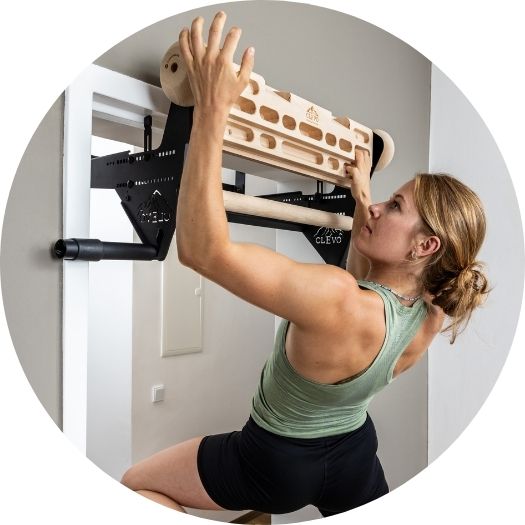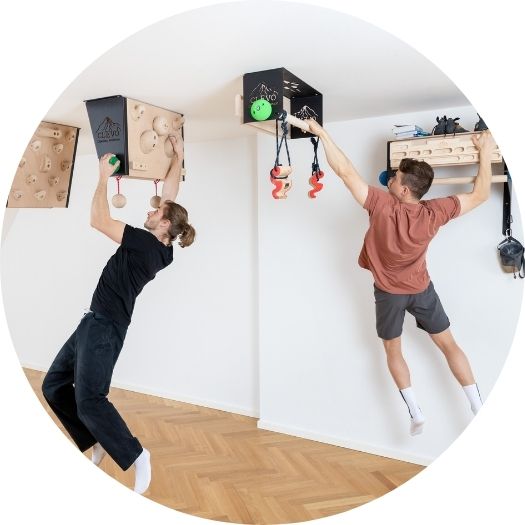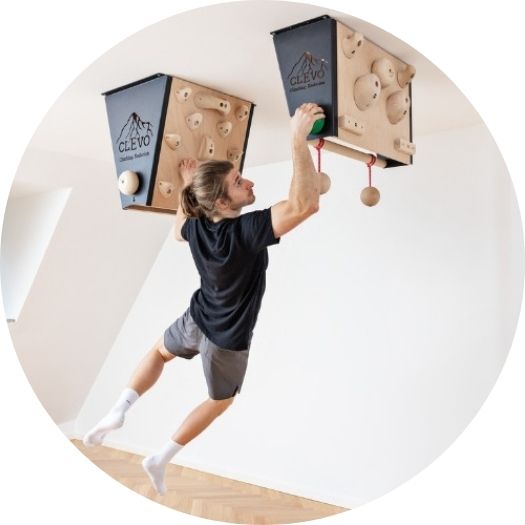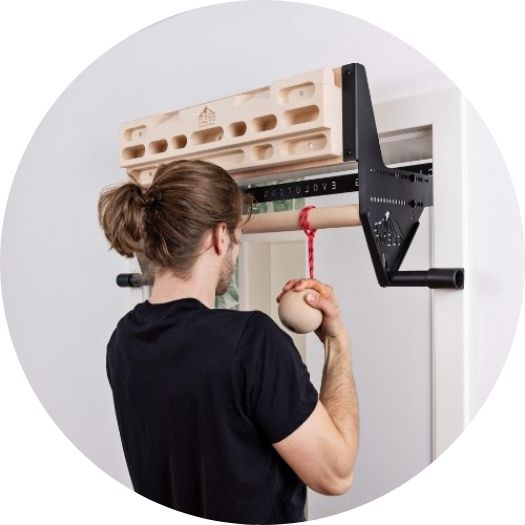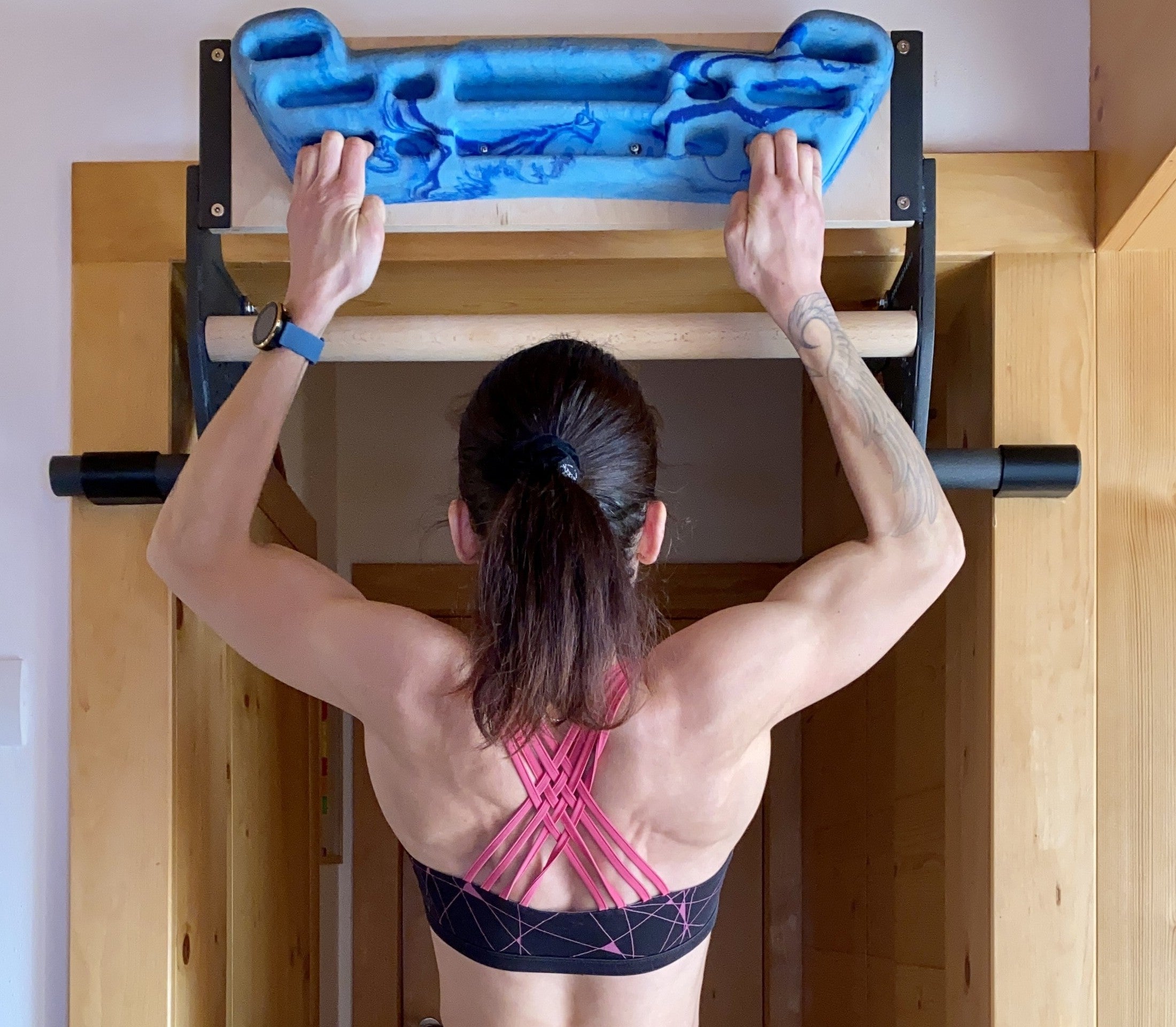You are a passionate climber, but the weather does not play along? Or you lack a mountain range on your doorstep where you can spontaneously work off your energy after work? According to relevant statistics, 95% of German citizens do not have a mountain range in front of their door, among climbers it is still 92%. 😉
Joking aside... Nevertheless, it should be clear: Many climbers would like to pursue their hobby more often, but they rarely find the right conditions in their surroundings. In order to not always have to rely on good weather or wait until the next weekend trip to the mountains, you will learn in this blog post three options for indoor climbing.
Compact comparison: outdoor climbing vs. indoor climbing
|
Advantages |
Disadvantages |
Outdoor climbing |
|
|
Indoor climbing |
|
|
Especially beginners who are taking the first steps in climbing, we recommend indoor climbing. Gradually, it is possible to slowly approach outdoor climbing.
Outdoor climbing offers a unique experience of nature and, due to the heights to be climbed, an impressive adrenaline kick! To perform well outdoors, climbers should avoid too long training breaks in autumn, winter and spring. This is where indoor climbing proves helpful.
Ultimately, it pays to climb indoors regularly to stay fully in rhythm and improve one's climbing skills through targeted training. This sets the course for being able to perform as usual (or even better!) outdoors later on.
Convinced? Then check out our three suggestions for indoor climbing below!
Option #1: Bouldering and climbing gyms

There are bouldering and climbing gyms. This contain walls that have holds attached to them. The holds are arranged and colored to form clearly marked routes. Along these routes you boulder or climb. By the way, the difference between bouldering and climbing is the height: in bouldering you climb at jumping heights of up to 4 or 5 meters, while in climbing you overcome heights of up to 30 meters or even more.
Bouldering gyms also allow for effective training!
Because of the low height, some climbers find bouldering boring or undemanding. Nevertheless, it is worth being a little more open to training in bouldering gyms, because bouldering gyms are more widespread than climbing gyms. Roughly, you could estimate that there are 5 bouldering gyms for every 1 climbing gym. In some cities you look for climbing gyms completely in vain.
Thus, the "proud" climber has the choice: Either persistently do without the training in the bouldering hall and thus do less sports or make the best out of the training in the bouldering hall. We, as sports enthusiasts, are clearly in favor of the latter!
Targeted training adapted to your performance level
Bouldering halls always contain several very challenging routes and also special training walls on which you can train your climbing skills very comprehensively. Despite the low heights, bouldering halls open up a wide range of possibilities for you to train in such a targeted way that next summer, when climbing in nature, you will be able to do routes that you didn't manage last summer.
So, whether it's bouldering at 4-5 meters or climbing at dozens of meters, indoor climbing in halls always gives you numerous routes, training equipment and other opportunities to train your skills comprehensively and purposefully individually.
Social component and beginner friendliness
At the same time you benefit from the social component, because in halls usually meet more people than in outdoor climbing. You can learn from other people or teach them yourself. Maybe you will meet new friends? Especially beginners will find it easier to get into the sport because of the safety of indoor climbing at jumping height and the motivation thanks to the other people in the hall.
Costs and crowded halls as disadvantages
Few disadvantages, but we do not want to deprive you of them... You have to pay entrance fee when visiting bouldering and climbing halls. If you train frequently, monthly tickets, 10-person cards, subscriptions and similar offers with reduced prices make sense and reduce the cost disadvantage. In addition, some bouldering and climbing gyms have discounts for students or people in a certain age group.
During vacations, weekends, and off-holiday weekday afternoons, crowded gyms are a common occurrence. Make sure to check out the peak times - sometimes Google lists the peak times in the search engine - and try to go to the hall outside of the peak times. This way you avoid overcrowded halls and long waiting times until routes become free.
However, from practical experience we can say that even in crowded halls, routes usually become free after less than 1-2 minutes. This is mainly due to the fact that the range of routes is large, and thus boulderers and climbers are less likely to get in each other's way during training.
Option #2: Private climbing wall at home

Your own climbing realm at home? A place where no one disturbs you during training and where you can live out your training to the maximum individually? That sounds so cool that the blood rushes to the climber's biceps right away! 💪 But as cool as the idea may sound, you should at least as much adapt your training requirements to the conditions at home.
You probably have less ceiling height at home than in a bouldering gym. Climbers who already have a problem with the "paltry" 4-5 meters of climbing height in a bouldering hall will therefore most likely not warm up to a private climbing wall at home.
Training specific climbing skills
If you are willing to compromise, you can hit the bull's eye with a climbing wall at home! Unlike climbing routes in nature and the routes in bouldering as well as climbing gyms, it is namely possible with your own climbing wall to design the routes completely according to your own imagination.
You can choose the shape of the mounted holds in terms of width, depth and length, among other things, and arrange them according to your wishes. For example, you can specifically train your finger strength by choosing holds and ledges with a shallow depth. By placing the holds at great distances from each other, you ensure that you train your agility on the climbing route.
Time saving by training at home
You save the time to go climbing in the nature or in the hall. If you have little energy after work during the week, this time saving is precious. You just drop your stuff at home and get started right away with a short and crisp workout at home.
No regular entry costs, but one-time high purchase costs
On the one hand, you save the entrance fees that training in a bouldering or climbing gym requires. But on the other hand, you have the one-time purchase costs that you need for the material to build the climbing wall.
Oh, yes: Of course you have to build the climbing wall. Or you can have it built by a talented helping hand. Either way, the construction work has to be done first, which discourages most from building their own climbing wall at home.
Are the minimum requirements for the space needed met?
A common obstacle to building a climbing wall: a climbing wall at home needs space. Optimally, it should be at least 3 meters wide and 3 meters high. In old buildings with large rooms and high ceilings, these spatial requirements should be easily met.
If you do not meet these spatial requirements, the training on the climbing wall will be rather spartan. This is not a bad thing, because even small climbing walls can provide efficient training of specific skills.
However, if you don't have much space, you don't necessarily need a self-built climbing wall. How about getting prefabricated modules instead, which you can equip with campus bars, holds and other climbing accessories for your training? accessories for training?
Option #3: Prefabricated modules

Why go to the trouble of building a climbing wall yourself when there's a perfect solution with prefabricated climbing modules? Prefabricated modules are relatively small, as they usually come in at less than three feet each in length, width, and depth.
With their small size, the modules are in no way comparable to the possibilities of indoor climbing in halls. They still offer you an excellent chance to train individual skills, so you don't get rusty if you can't climb outside or can't find the time to train indoors.
Space-saving and versatile at the same time
Despite their compact size, the climbing modules are multifaceted. You can equip them as you like: campus bars, fingerboards, climbing balls, climbing holds - you screw them on as you like. As soon as the training becomes too monotonous or you have improved your skills, you can rearrange the ledges, grips, etc. to completely redesign the climbing module.
Due to the possibility of individual attachment of your training equipment, there are no limits to the training of your skills with the help of the climbing modules. Nevertheless, the modules have small dimensions and are, despite all their versatility, compact training equipment that you can possibly use regardless of location. Door modules, for example, can be hung in various door frames.
Large selection and various combination possibilities
You can combine the climbing modules as you wish. It does not have to stay with one wall module, but you can put two together and thus create even more options for your climbing training at home. Take advantage of the large selection of modules and the useful accessories with which you can combine the modules!
With this you lay the foundation: |
You can use these accessories: |
On the module you screw the campus bars, the fingerboard, the climbing holds or the hemispheres. Each of the three modules also has an integrated pull-up bar. All in all, you will not lack for training options. To briefly introduce you to the possibilities of the accessories, here is a brief overview of their features:
- Campus Bars
A shallow bar that you use for finger training - you really have to hold on tight here.
- Fingerboard
The absolute burner for finger training - various grip surfaces with different depths for holding on with 2, 3, 4 or 5 fingers.
- Climbing holds made of wood
Grips in different shapes and sizes - normal grips that you can attach to your module as you see fit.
- Half balls
Half spheres as climbing holds - more demanding training, because you have less firm grip surface than with the usual climbing holds.
As far as the modules themselves are concerned, you have the most leeway with the ceiling modules, as these provide the most surface area for holding ledges, boards, holds and balls. You have the least surface area for mounting handles with the door modules, which in return you can take from place to place and mount in almost any door.
Acquisition costs and space limitations as disadvantages
If the ceiling height is not at least 2.35 meters, you will not have much fun with the ceiling module. If your room does not have this ceiling height or if there are other spatial restrictions, you will have to choose another module. Whether with us or with other manufacturers: There are always certain spatial requirements, so that the indoor climbing on the modules is possible or works well.
Another disadvantage is the initial cost of the module and accessories, but in contrast to a self-built larger climbing wall, the cost and effort of purchasing prefabricated climbing modules is often lower. In the long run, you save by purchasing modules for indoor climbing, because you do not have to pay the entrance fee to bouldering and climbing gyms every time for training.
Conclusion: Indoor climbing best in halls, but easiest at home
If you want to climb indoors, nowhere else you have so many routes and training equipment as in special bouldering and climbing gyms. Thanks to the options for a varied training, you will reach your goals faster through indoor climbing in halls. In addition, you benefit from the exchange with other like-minded people who like to devote their free time to climbing.
Unfortunately, it is not always possible to go to the hall and train there. In addition, in the long run, the costs are high. That's why it's a good idea to buy a climbing module just in case you need to do some crisp workouts at home. You invest in this and the matching accessories once and can subsequently benefit from it in the long term.
Optimal is the supplement of the possibilities for indoor climbing: For at home you have a climbing module including accessories, in addition you go, for example, 1 time per week to the bouldering or climbing hall to climb indoors. This gives you the maximum flexibility to work on your climbing skills individually at any time and in several places.
Our article has brought you further? You now know when and how to arrange your indoor climbing? Then help us to help other climbers and boulderers by sharing this post!

